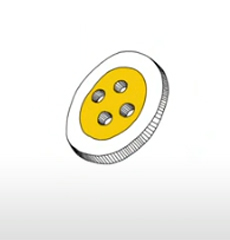
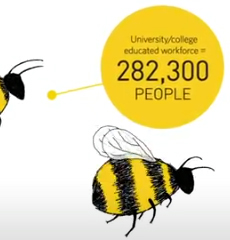
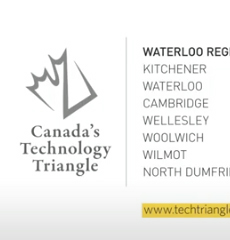
If you weren’t able to attend or watch the TEDxWaterloo event on Wednesday, March 21, 2012, we have written a blog about the highlights that we took away from this inspiring event. This is Part 2 of the blog; Part 1, is available on the blogs page of our website.
We were introduced to Jean Beliveau, who is known as the walker. This Montreal Native walked around the world for peace, a journey that took eleven years, 64 countries, 75 500 km and 65 pairs of shoes. He met people from all walks of life and was especially touched by a man of little means in South America who said, “I met people so poor that all they have is money.”
Next, we learned of a new development in technology. Aeryon Labs demonstrated The Scout, a remote controlled helicopter with an overhead camera.
Everyone enjoyed the Musical interlude with Roberta Hunt, performing her own melodies reminiscent of New Orleans.
Taylor Jones’ presentation touched all of us. His creation Dear Photograph has become an international success, all in the past nine months. The concept of the website, book and now television show is that people place an old photograph that has meaning to them in the modern setting where the photograph was originally taken. He explained that Dear Photograph has ‘become a platform for people t breath new life into older memories.’ Sharing what he believes to be the reason for the explosion of his concept, Taylor concluded: “I think that emotion is what brings us all together.”
Sarah Williams, an urban planner, shared how people use social media to express emotional connections that they feel with their local places and destinations. Through analysis of results from FourSquare and Facebook, you can build an emotional map pf your urban environment.
Co-host Matt Gorbet shared the concept of TEDx in a Box, a portable way to allow developing communities to hold their own local presentations. TEDxWaterloo is the first TEDx event to get behind the project and donate a box.
Eli Pariser unveiled how internet-algorithms are acting like gatekeepers. There is no standard Google anymore; everyone gets their own tailored results, depending on what they have searched in the past and dozens of factors. “This moves us very quickly to a world where the Internet shows us what it thinks we need to see but not what we need to see.” He advocates a more open Internet.
Peter Katz closed the second part of the event with his remarkable music performance. He shared the story of an inspiration of his, Oliver Schroer, one of the world’s best violin players, Oliver died of leukemia in 2008, but he by the news of his untreatable cancer; Peter revealed, when the doctor told Oliver the news, he was overwhelmed with a feeling of peace. “He was already doing what he wanted to do with his life. All he had to do was keep doing it.”
Our John and Rebecca Short were thrilled to attend the third annual TEDx Waterloo event. TED is a non-profit organization that spans across the globe. The ‘x’ stands for independently organized events.
Events, similar to the one held in Waterloo, are being held all over the world. There are 2000 of these events taking place, this year. These events have been held on every continent, including Antarctica. A TEDx event was even held on Mount Everest! Canada can boast that we are the third most populous in TEDx events worldwide. There have been 168 of these events in our country. Not all of the events are as large as the one held in Waterloo, 1500 attendees, but they all share the same message: Ideas worth spreading.
TEDxWaterloo was a success with social media, especially Twitter. #TEDxWaterloo was almost instantly trending and quickly become the top trend in Canada. Almost all of the speakers for the event also made the top 10 list of trending Twitter topic for the nation.
The event was split into three sessions. The theme of the first session was that ‘from disconnected we get to connected disciplines.’ There are too many highlights from the event to fit into a reasonable sized blog but we will share a few of them.
The first speaker, Scott Chantler, a comic book writer, explained how content is what is truly important. If the content is interesting and grabs the attention of the viewer, the form of media will fade in importance. He also showed through sketches that taking a step back allows for emotion.
Next was playwright Shannon Blake. She shared the importance of artist-community interdependence. She explained, “In artist-community interdependence, the art is excellent. It’s real art… The artist realizes that she needs the community and the community realizes that they need the artist.”
Bilge Demirkoz, from Turkey, spoke via an electronic link. She talked about what it meant to be a scientist and how this stereotype is evolving. She also discussed how science and art are linking more now that ever before.
Then we saw Matthew Ho, the high-school student who, with a friend, sent a Lego man into space. He wanted listeners to think about reasons why people saw, “I can’t.” He narrowed it down to two reasons: the fear of failure and a lack of passion.
We also heard from Angela Belcher. She gave United States President Obama a periodic table. He replied, “Thank you, I will review it periodically.” She also expressed her desire to have a virus-powered car and the new possibilities that our future holds.
The final speaker of Part One of the TEDxWaterloo event was Krister Shalm, a swing-dancing physicist. He had a special guest help him to explain quantum entanglement, a magician with an intriguing card trick. He also used a chessboard and M&Ms to explain exponential speed. He finished off the first part of the conference with by participating with a dance group to illustrate quantum entanglement.
He explained, “Dance is a very powerful way to illustrate these ideas.” He was joined electronically on screen, by over 300 dancers worldwide in 64 countries.
As the first session ended and everyone went for break, the announcers encouraged everyone to shake the hand of someone they have not met before. That is truly the way that we can spread ideas worth sharing to cover the world.
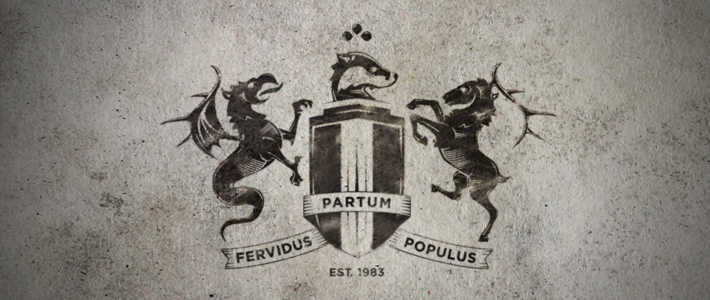
Once upon a time (1983), we established a Kitchener based communications agency. There have been a lot of changes since then so, last year, in conjunction with our move to the Tannery in Kitchener, we decided to re-brand our business and call ourselves Machteld Faas and Xander.
Since you¹ve read this far, you are probably wondering who are these people with the strange names?
First of all, you need to know that it’s made up—we wanted to maintain the equity we had in the name MFX and then got a bit creative. Second, the name was created to embody the values of our owners and founders, John and Rebecca Short. As the company grows, we wanted a way to communicate to staff and customers the core values that drive our success as a creativity firm.
Why Machteld, Faas and Xander?
These aren’t names you usually hear on the street in North America. Often in naming a company, an invented name is easier to trademark and create meaning around since it has no other connotations. Picking typical English names borrows feelings and emotions that others might have about them. Machteld, Faas and Xander are distinct and rare, which allow us to embody the values and stories that are important to us.
Machteld
Based on the Creator archetype, Machteld encourages our creative expression, not just among our typical ‘creative’ team, but also throughout the organization. As a core, driving organizational value, Creator encourages us to remember that everyone is creative and that it is our job to help enable creativity through design. Machteld Faas Xander values imagination, beauty and designs that are both aesthetic and functional. As a core driving value, staff is encouraged to remember Machteld’s guidance and look for ways to embody creativity in every facet of the company.
Faas
Based on the Explorer archetype, Faas encourages our self-guided learning culture. Fiercely independent, Faas inspires a flexible, self-starter working environment. As a core, driving organizational value, Explorer encourages us to experience a better, more authentic work life. Machteld Faas Xander values self-guided learning and provide tools to support individual employees’ journey through their careers. Faas guides the learning and professional development side of our company.
Xander
Based on the Magician archetype, Xander inspires the way we get things done. Design is a visual-language based discipline and so it’s appropriate that Xander helps us remember that the best way to inspire people is by showing them. MFXers value the social aspect our work and are good at driving consensus through participation, ultimately achieving goals for clients. We believe that when we come together in a fun, positive, open environment‹people can accomplish anything.

Greetings. Here at Machteld Faas Xander we were thrilled to learn that Colliers International has nominated our workspace in a Canada wide search for the ‘Great Companies Need Great Spaces’ contest.
The contest aims to recognize companies investing in spaces that aspire to be more than just places to work but places to innovate, collaborate, give back and have fun.
For those of you that have not heard of our new home, we moved last year into the Tannery, an 800,000 sq. ft. re-purposed manufacturing facility that is also home to, among others, Google, Desire2Learn and Digital Media Hub.
“We were completely surprised and thrilled to be nominated,” exclaimed MFX President John Short. “The goal of our 5,000 sq. ft. build-out was to create an inviting, flexible work space that celebrated the Tannery’s history with a complementary, modern office design. The layout and flow works to facilitate the innovative way our staff and clients collaborate together. The budget wasn’t huge, we had no award aspirations.”
Finalists from across Canada, including MFX, were announced at the annual Colliers National Office Leasing Conference attended by office leasing specialists and managers from across the country. The 2-day conference was held in late November at the One King West Hotel in downtown Toronto. Top prize in the contest went to the Vancouver Law firm Fraser Millner Casgrain.

The fifth annual ‘Plant of the Year’ award ceremony and Gala was a fantástico success.
Due to the sensation of last year’s gala, the pressure was high to design an engaging and memorable night. The event has become a highlight celebration, with all the major players of the industry and more attendees with every year.
The occasion is the continent’s premiere conference and show for the industry. The Innovative Steam Technologies (IST) held the award and reception at PowerGen in Las Vegas.
Machteld Faas Xander had the privilege of designing and assembling the direct mail gala invites. Wanting to raise anticipation for the night, we integrated the traditional Spanish theme through use of bold colours and rich textures. Photographs and images of traditional symbols of Spain completed the mood of the invitations.
With Spanish flare, the 2011 Plant of the Year Award achieved the best-ever response and participation rate at the gala.
OLÉ!

Ahoy! February 16 was the date pf Hybrid’s annual hospitality suite for the National Turkey Federation. The theme was Ye Gobbler’s Revenge, a traditional pirate mood to celebrate the tradeshow being hosted in the National Football League’s Tampa Bay Buccaneer’s hometown.
Hybrid, a Hendrix Genetics Company, is the world’s largest primary breeder of turkeys. They are international in over 50 countries but the have been operating out of their Waterloo Region head office in Kitchener since 1953.
Year after year, excitement for the Hybrid reception rises due to its 15 years of brilliant receptions and stellar reputation. It is the most anticipated meet and greet, with their delicious buffet and visitor gifts. The reception is especially known for the high quality food. This year, every guest was presented with a keep-sake knife as a souvenir for attending.
Machteld Faas Xander was brought on board to bring the theme alive. The provocative invitations and unique event visual identity played a large role in the evening’s success. The turkey mascot, Gobbler, was used to advertise the event, using the old wooden-boat textures contrasted with the colourful illustrations of Gobbler. Coasters have been a continual hit at the annual show so they designed a duo-sided coaster that was placed around the tradeshow and hotel bars to build excitement for the suite.
The hours of hard work paid off with the results of the night. Both attendees and planners were pleased with this year’s hospitality suite. Visitors are already looking-forward to what Hybrid will plan for next year’s event.
Yo-Ho-Ho!
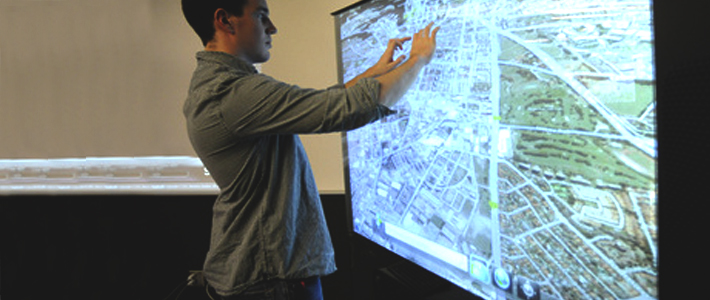
Young entrepreneurs anticipate the future by combining Design Thinking with technological innovation at the
new ‘Felt Lab’ in St. Jacobs.
This just-opened, state-of-the-art, digital media project is the inspiration of the University of Waterloo’s Research Entrepreneurship Acceleration Program (REAP) and jointly-partnered by U of W, Quarry Integrated Communications (where the Lab is located), Christie Digital and Intel Corporation.
At the Felt Lab, students, faculty and industry experts freely explore new interactive technologies in an environment that fosters experimentation, prototyping and refinement of innovative ideas.
Rebecca and I were pleased to be invited to the grand opening of the Lab on October 26, and appreciated hearing more about the project from Alan Quarry. He explained that his company will also provide business and marketing mentorship for students who are interested in bringing their digital media innovations to market.
Commitments like these that made the Felt Lab possible are why the Region of Waterloo is such a magnet for talented entrepreneurs.
INTERESTING FACT! Parts of the Quarry building complex in St. Jacobs once housed a felt factory that dates back to
the 1800s.
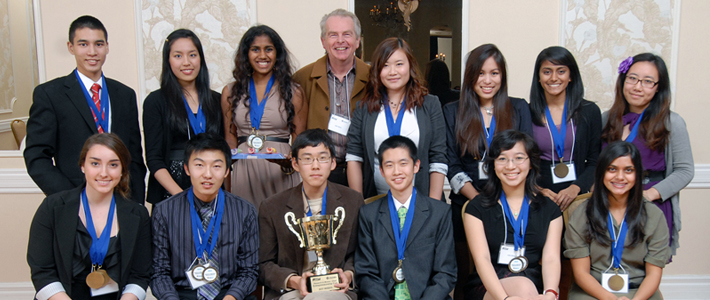
For over 30 years, the Shad Valley organization has been dedicated to bringing out the entrepreneurial spirit in Canada’s brightest and most engaged secondary school students.
The RIM-sponsored Shad Valley Entrepreneurship Cup this year, hosted young people at Universities across Canada for a four-week, summer enrichment adventure. At each campus, participants live in residence and together, create a company, develop a product, prototype it, prepare a marketing plan, and submit it for judging to determine a National Champion. For 2011, there were ten competing Shad Valley companies and 240 students participating.
The theme for this year’s competition was ‘improving the quality of life for a Canadian child with a disability.’
Each company was evaluated in seven categories: Best Business Plan, Best Application of Scientific Principles, Best Application of Theme, Best Website, Best Prototype, Best Marketing, and Best Overall Project.
At Machteld Faas Xander, we were asked to judge the ‘Best Website’ category. To do this, we looked at several key elements of website design including: